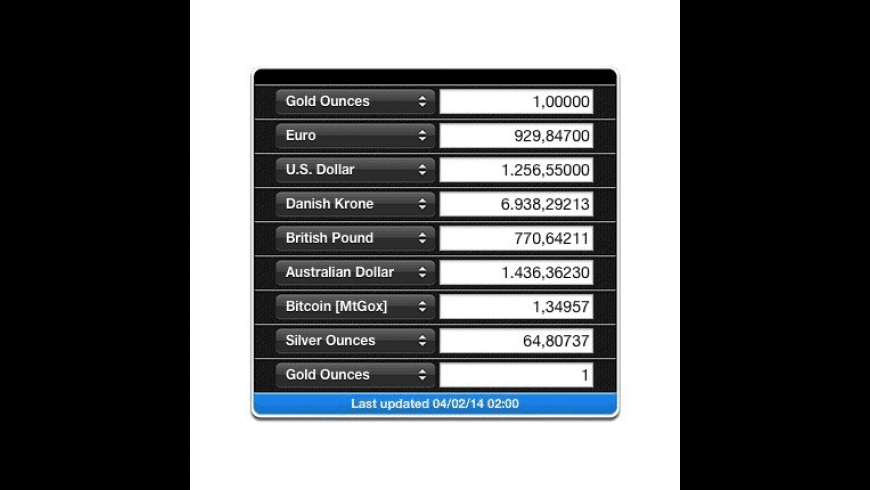Foreign currency translation is used to convert the results of a parent company's foreign subsidiaries to its reporting currency. This is a key part of the financial statement consolidation process. The steps in this translation process are as follows:
You only have to insert the amount of money and choose the initial and final currency. Currency Converter will do the rest. Currency converter obtains by itself the conversion factor and calculates the result for you. No matter where you go because it includes all. Upgrade from Currency Assistant 3.x to Currency Assistant 3.3.1 is free. Currency Assistant will automatically convert all the pasted amounts and log results in the tape. Equivalently, you can import plain text files, RTF files, Word documents, OpenDocument text files, web archives, HTML files, and text clippings containing series of. The service constantly aggregates exchange rates from the most reliable and trusted e-currency exchangers and presents them in the form of a well-structured and dynamically updated table. Clicking a currency pair brings up a list exchangers with the best rates, while clicking a specific exchanger's name opens a corresponding website. Calculate live currency and foreign exchange rates with ebixcash world money's free currency calculator. Calculate exact amount of travel money at current exchange rates. Prepaid travel cards and forex cards) are a safe and convenient alternative to cash while travelling overseas. Simply visit any VISA accepting ATM and withdraw cash.
Houdahspot 5 0 11 percent. Determine the functional currency of the foreign entity.
Remeasure the financial statements of the foreign entity into the reporting currency of the parent company.
Record gains and losses on the translation of currencies.
Determination of Functional Currency
The financial results and financial position of a company should be measured using its functional currency, which is the currency that the company uses in the majority of its business transactions.
If a foreign business entity operates primarily within one country and is not dependent upon the parent company, its functional currency is the currency of the country in which its operations are located. However, there are other foreign operations that are more closely tied to the operations of the parent company, and whose financing is mostly supplied by the parent or other sources that use the dollar. In this latter case, the functional currency of the foreign operation is probably the dollar. These two examples anchor the ends of a continuum on which you will find foreign operations. Unless an operation is clearly associated with one of the two examples provided, it is likely that you must make a determination of functional currency based on the unique circumstances pertaining to each entity. For example, the functional currency may be difficult to determine if a business conducts an equal amount of business in two different countries.
The functional currency in which a business reports its financial results should rarely change. A shift to a different functional currency should be used only when there is a significant change in the economic facts and circumstances.
Example of Functional Currency Determination
Armadillo Industries has a subsidiary in Australia, to which it ships its body armor products for sale to local police forces. The Australian subsidiary sells these products and then remits payments back to corporate headquarters. Armadillo should consider U.S. dollars to be the functional currency of this subsidiary.

Currency Assistant 3 2 6 – Convenient Currency Conversion Chart

Currency Assistant 3 2 6 – Convenient Currency Conversion Chart
Armadillo also owns a subsidiary in Russia, which manufactures its own body armor for local consumption, accumulates cash reserves, and borrows funds locally. This subsidiary rarely remits funds back to the parent company. In this case, the functional currency should be the Russian ruble.
Translation of Financial Statements
When translating the financial statements of an entity for consolidation purposes into the reporting currency of a business, translate the financial statements using the following rules:
Currency Assistant 3 2 6 – Convenient Currency Conversions
Assets and liabilities. Translate using the current exchange rate at the balance sheet date for assets and liabilities.
Income statement items. Translate revenues, expenses, gains, and losses using the exchange rate as of the dates when those items were originally recognized.
Allocations. Translate all expense and revenue allocations using the exchange rates in effect when those allocations are recorded. Examples of allocations are depreciation and the amortization of deferred revenues.
Different balance sheet date. If the foreign entity being consolidated has a different balance sheet date than that of the reporting entity, use the exchange rate in effect as of the foreign entity's balance sheet date.
Profit eliminations. If there are intra-entity profits to be eliminated as part of the consolidation, apply the exchange rate in effect on the dates when the underlying transactions took place.
Statement of cash flows. In the statement of cash flows, state all foreign currency cash flows at their reporting currency equivalent using the exchange rates in effect when the cash flows occurred. A weighted average exchange rate may be used for this calculation.
Mininote pro 5 4 hp. If there are translation adjustments resulting from the implementation of these rules, record the adjustments in the shareholders' equity section of the parent company's consolidated balance sheet.
If the process of converting the financial statements of a foreign entity into the reporting currency of the parent company results in a translation adjustment, report the related profit or loss in other comprehensive income.
Related Courses
